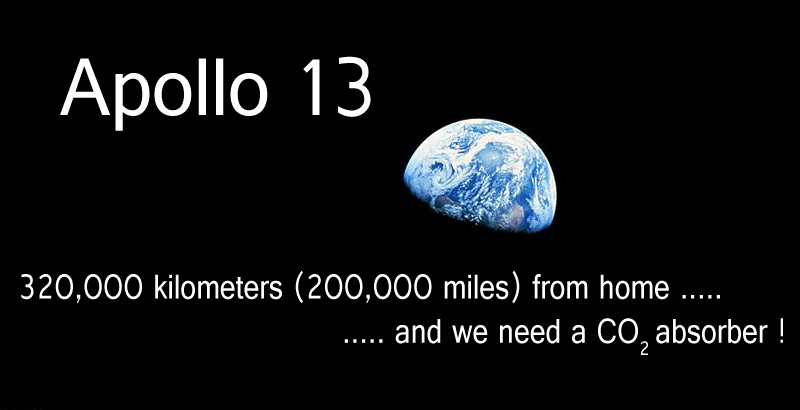
Unless you are an anaesthetist, you probably wouldn’t know what a carbon dioxide absorber is (red arrow below).

However, for a brief period in the year 1970, carbon dioxide absorbers were what everyone was talking about. This is the story of Apollo 13 which blasted off in 1970 towards the Moon. However, things did not go according to plan and an explosion in the spacecraft left three astronauts stranded 200,000 miles from home. Suddenly this story became headline news. The whole world got to know how the astronauts survival depended on if they could make a carbon dioxide absorber using the limited materials available in their spacecraft.
On July 21, 1969, Neil Armstrong stepped off the ladder of his space craft and became the first human to walk on the Moon. The first words spoken by him on the Moon that day are still remembered.
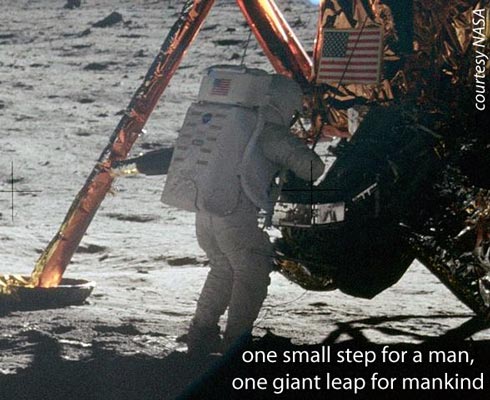
The first lunar landing was part of a series of space missions of the Apollo Space program. On April 11, 1970, it was the turn of Apollo 13 to lift off. This was going to be the third team to land on the Moon. The three astronauts (Lovell, Swigert, and Haise) for this mission were sitting on a massive rocket that would take them into outer space. The rocket (Saturn V), shown below, was about 110 meters tall (360 feet), had a diameter of about 10 meters (33 feet) and weighed about 3,000,000 kilograms (6,500,000 pounds). To appreciate the size of this mammoth rocket, compare its height with the man standing near it (tip of red arrow).
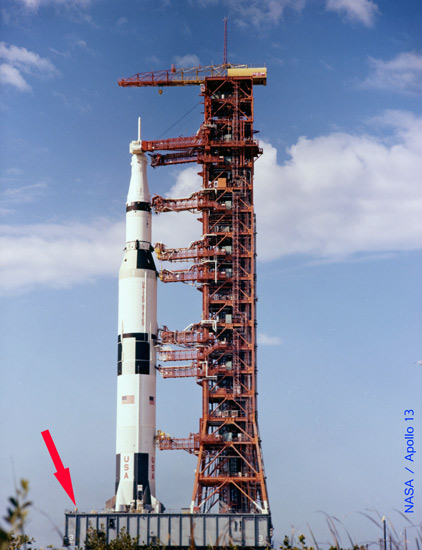
If you are superstitious and believe that the number 13 is not lucky, then you will be forgiven to think that the launch time was rather “unlucky”. Apollo 13 launched at 13:13 ( North American Central Time Zone ).
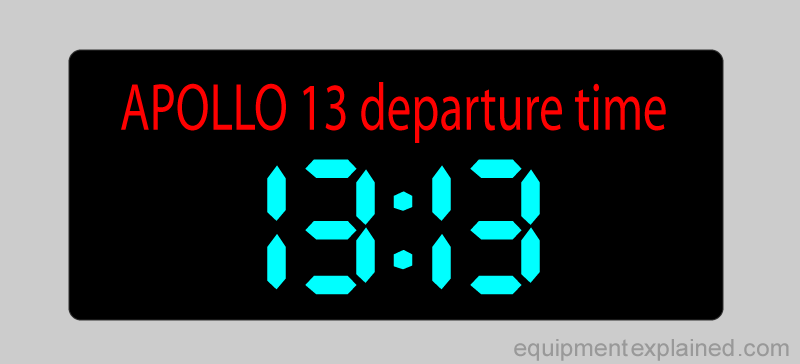
The image shows the gigantic rocket launching into space.

Within one minute of lift off, the rocket was travelling at the speed of sound. The rocket was built of various sections and as it went up into space, to avoid carrying unnecessary weight, it was designed to discard sections of itself that were no longer of any use (e.g. parts containing empty fuel tanks). Below is an image of a rocket throwing away a part of itself as it made its way to outer space. These massive pieces fell into the sea ( hopefully not hitting any fishermen below !).
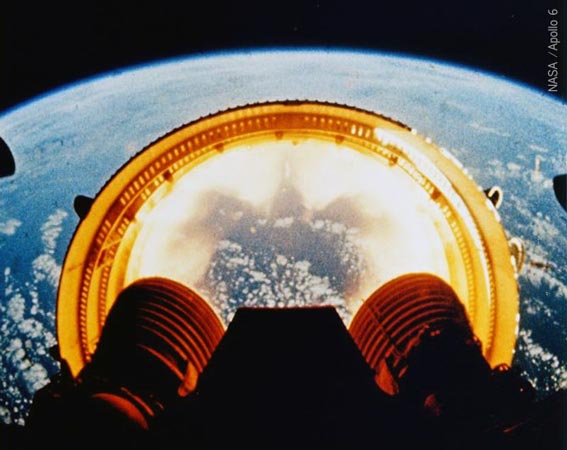
Within about 15 minutes the astronauts reached outer space and started orbiting around Earth. The their orbiting spaceship would have looked like this.
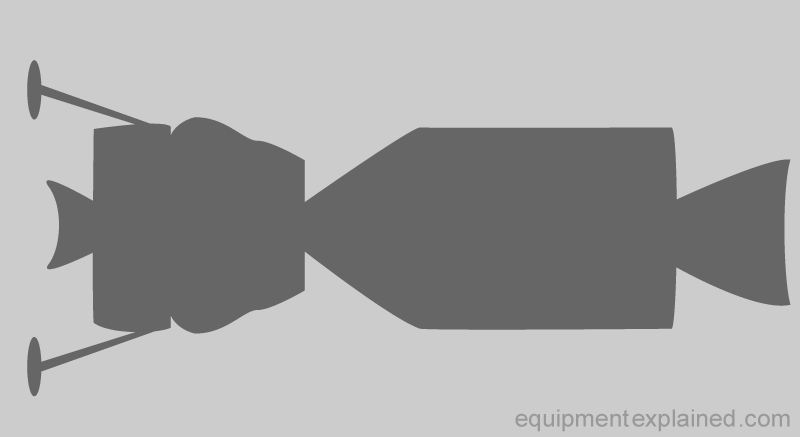
The “spaceship” actually consisted of three parts. These parts will be briefly explained to you so that you will later better understand the drama that took place in this mission.
Let us begin with the “command module “. This is a rather cramped compartment (shown in green below) in which the three astronauts mostly travelled in.

The command module was attached to a large section called the “service module “. This had an engine to take the astronauts towards the moon and back again towards Earth. Importantly, the service module also provided life sustaining functions for the astronauts, such as giving oxygen, water and electricity.
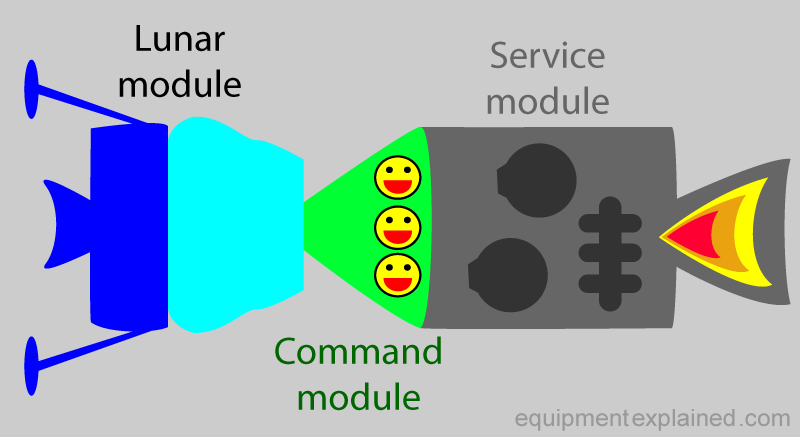
The service module had tanks of liquid hydrogen and liquid oxygen. It also had special devices called “fuel cells”. These fuel cells were able to take hydrogen and oxygen from the tanks to produce water and electricity.

Here is an picture of an actual fuel cell.
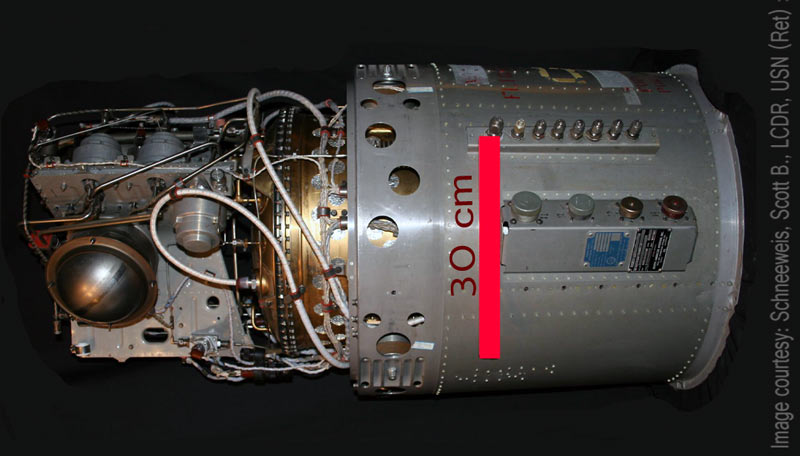
So you can see that the service module provides vital supplies of oxygen, water, and electricity for the astronauts sitting in the command module.
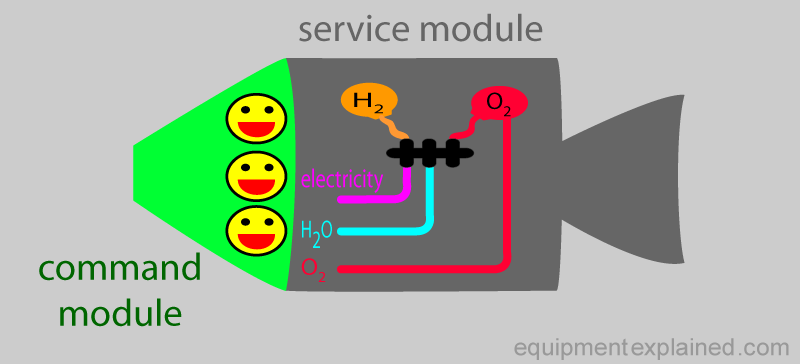
Here is an actual picture of a command module and service module attached together.
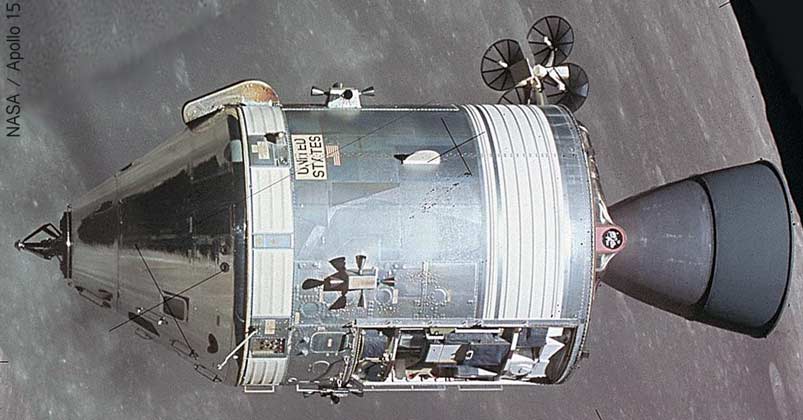
The third part of the “space ship” is the lunar module.
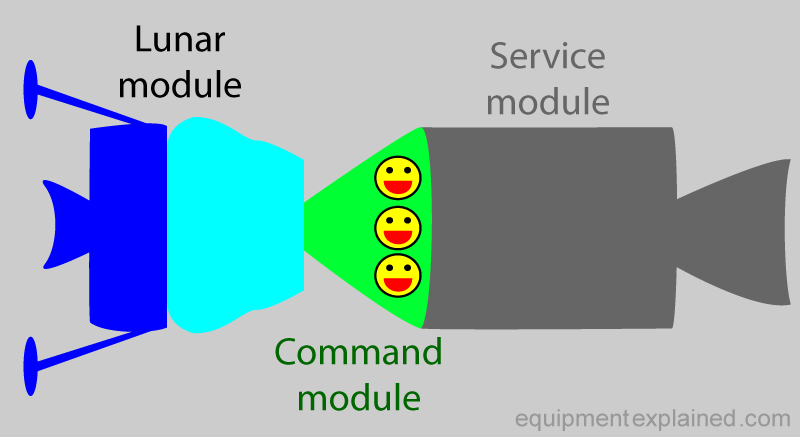
The lunar module is used to descend to the Moon, and of course, return back up as well. You will understand the role of the lunar module and the other parts better if I briefly describe to you how a typical Moon mission is expected to happen. Please note that Apollo 13 had a mishap and could not do what is described below. However, by understanding what should have happened, you will better understand the drama that actually happened.
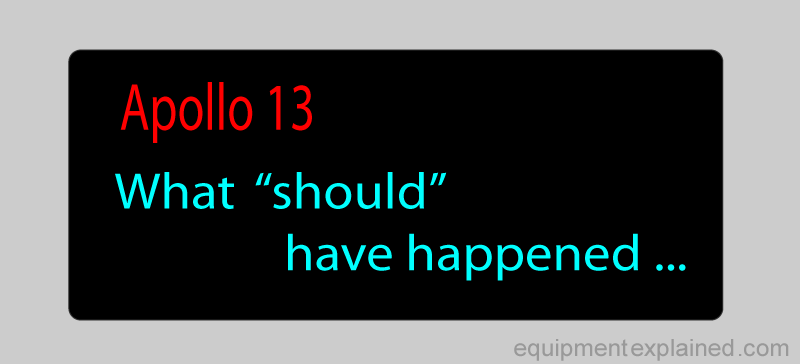
So, if things went according to plan, the spaceship , with its three main components, would have arrived at the Moon and orbited around it.
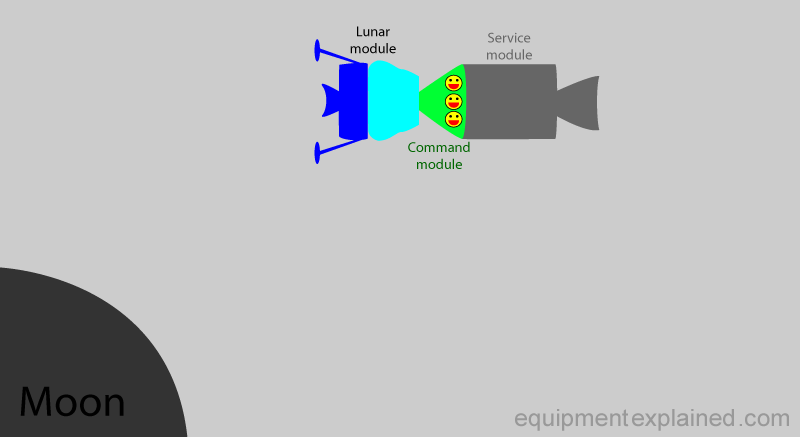
Two of the astronauts would move into the lunar module. Unfortunately one unlucky astronaut would have to remain back in the command module to look after it.

The lunar module, with the two happy astronauts, separates from the command module and descends onto the Moon.
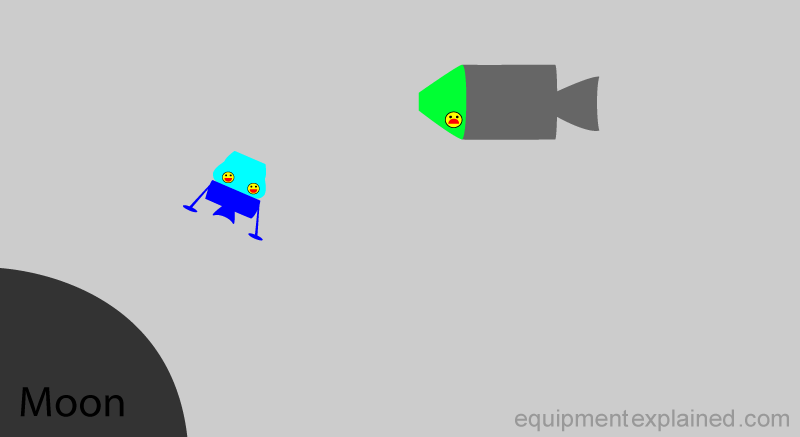
Once safely down on the Moon, they would prepare to get out and explore the surface.
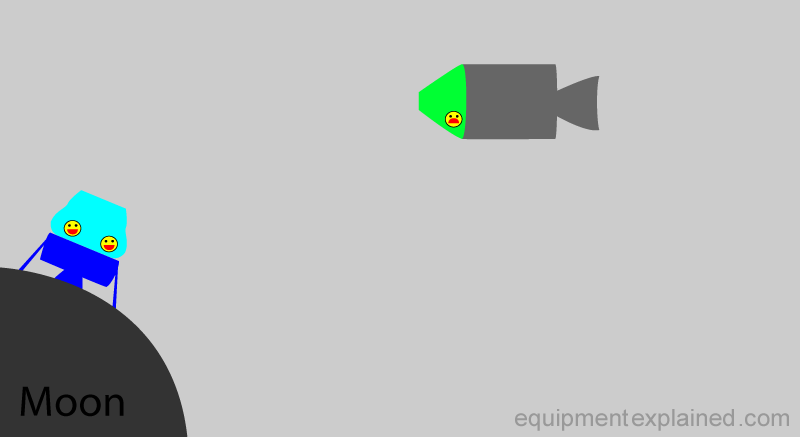
The astronauts would get into their space suits and venture out of the lunar module.
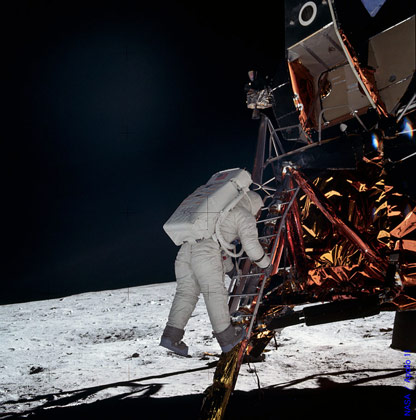
Many missions even took along a “car” to explore greater distances.
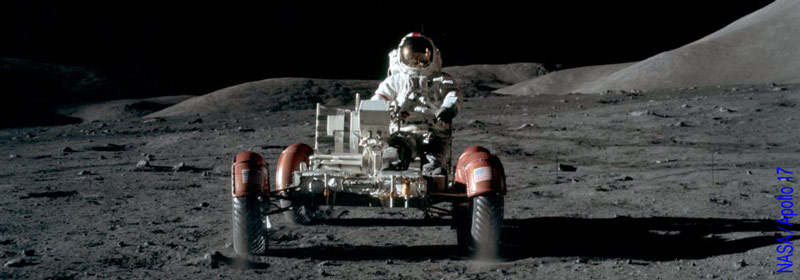
After the two astronauts would have enjoyed exploring the Moon, they’d get back into the lunar module. This has a small engine that blasts them away from the Moon.
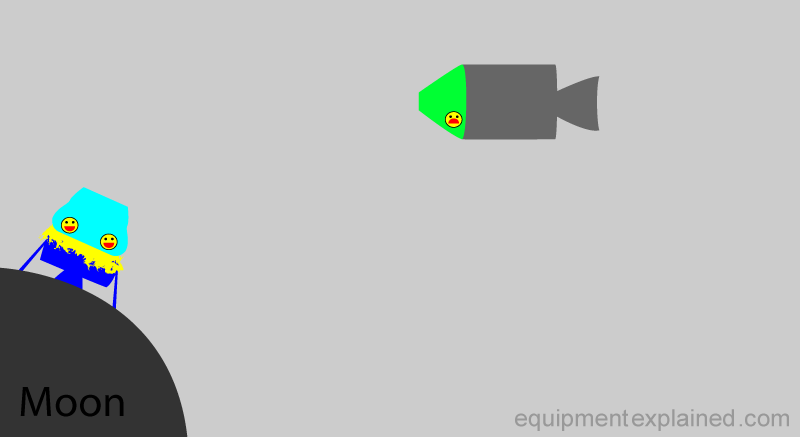
The lunar module takes them back towards the command module floating above. A part of the lunar module (dark blue below) is not required any more and is therefore left behind on the Moon (yes, we humans have polluted the Moon).
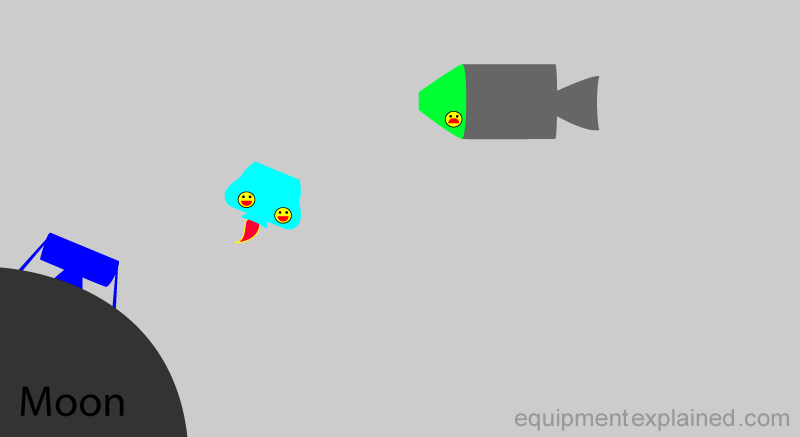
The lunar module then rejoins the command module. The two astronauts move back into the command module and share their stories with the jealous colleague who they left behind.
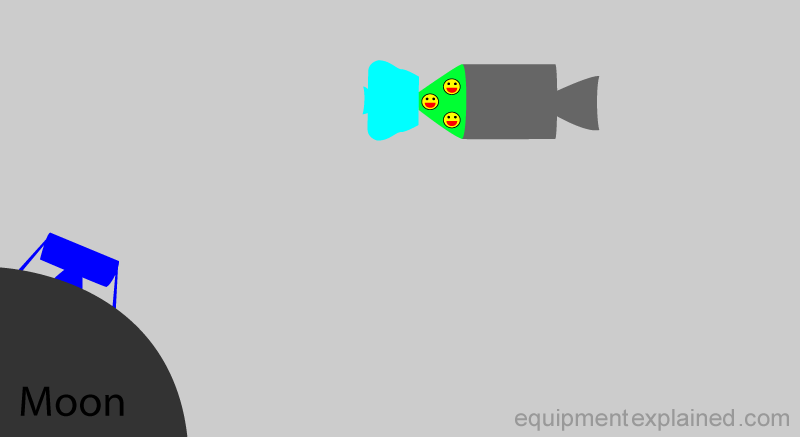
The lunar module is now thrown away as it is no longer needed.
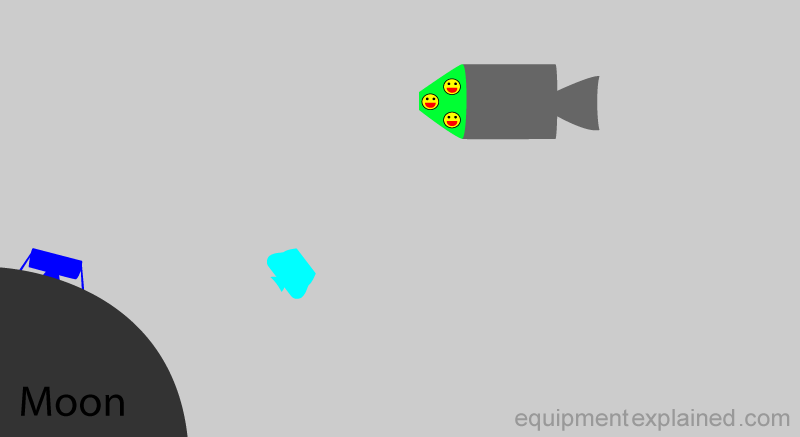
The service module brings the command module, with its three astronauts, towards Earth.
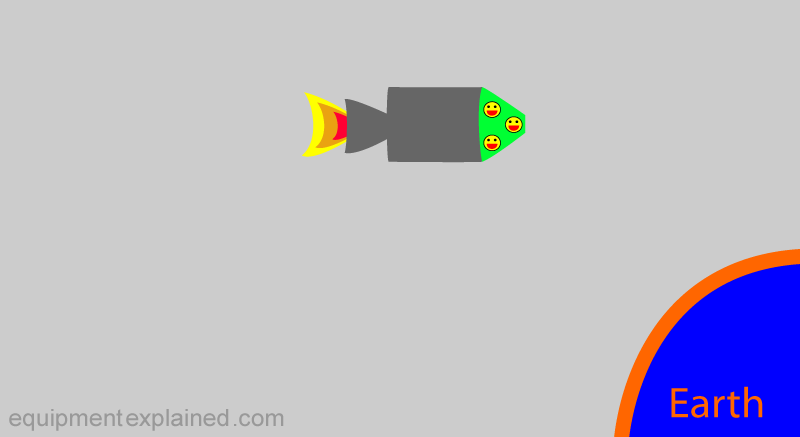
The command module then separates off the service module.
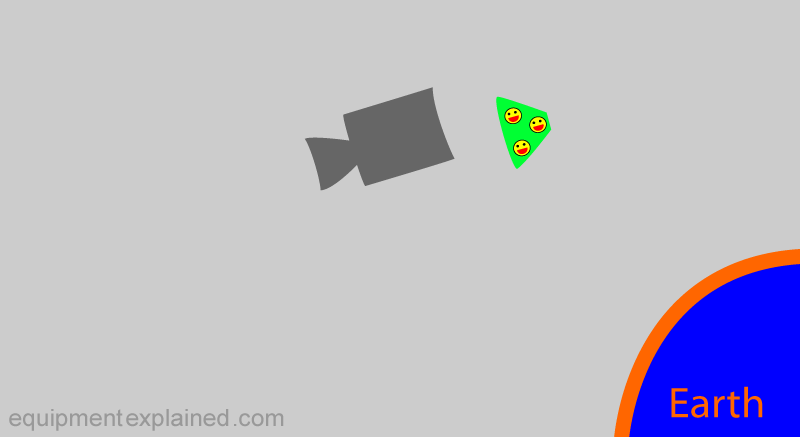
The command module, with its three astronauts, now “falls” into Earth.
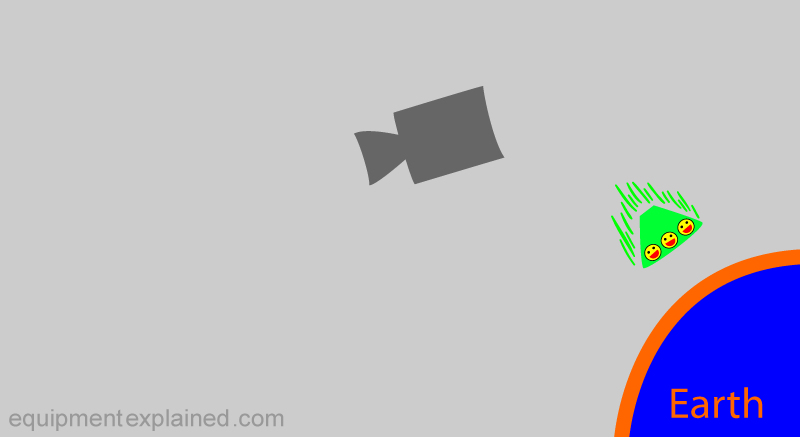
Towards the end of the journey, large parachutes open and help slow the command modules fall towards Earth. It eventually splashes onto the ocean and the astronauts would be rescued by a waiting ship.


Now, the above sequence is what should have happened if everything went to plan for Apollo 13. Here is the drama that actually happened.
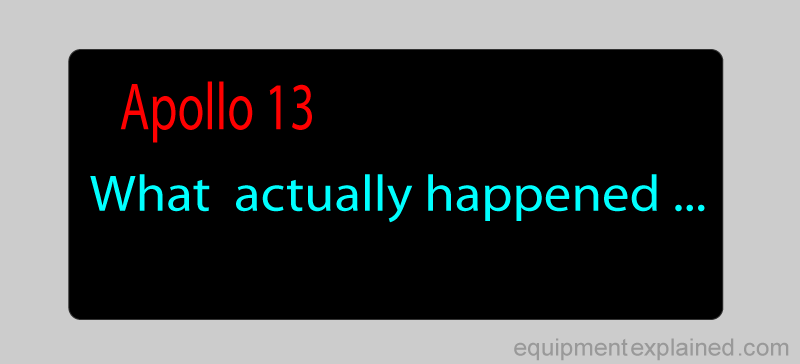
If you are into believing that the Number 13 is unlucky, you will find it interesting that the date things started going wrong for Apollo 13 was on April 13, 1970 ( North American Central time zone).

The space flight had so far gone on for nearly 2 days with no huge problems.
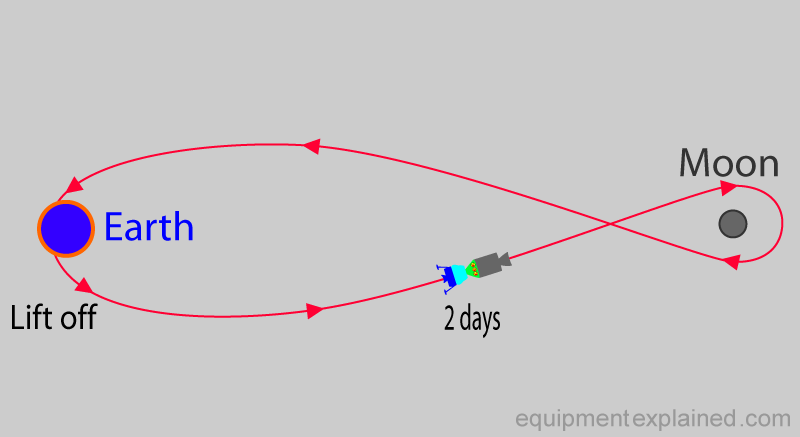
As part of their “public relations” duties, the astronauts were required to make regular live TV broadcasts from space. Shown below is such a broadcast appearing on the main screen of the control room. The sad thing was that by the time Apollo 13 was flying, the public were no longer fascinated by journeys to the Moon. Most TV networks didn’t even bother to show these live broadcasts, choosing instead to show comedy shows etc. Nevertheless, the astronauts did their duty and did these regular live shows.

However, two minutes after one such broadcast everything changed. Suddenly Apollo 13 would be headline news. It all began with the astronauts hearing a loud bang.

The service module had two oxygen tanks keeping liquid oxygen under very high pressure. One of the two oxygen tanks in the service module had exploded.
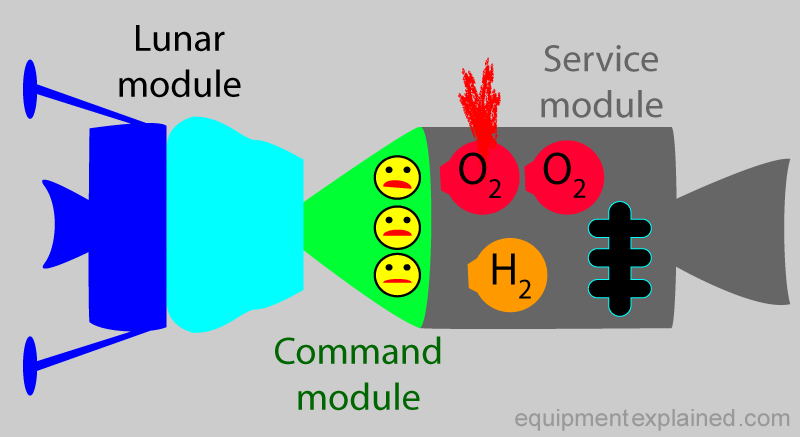
Clearly this was not good news, but there was even more bad news to come. The explosion of the first oxygen tank had also damaged the connections to the only remaining second oxygen tank too. This made both tanks tanks lose oxygen relatively fast.

You will recall that in the service module, the oxygen goes into the fuel cells to create water and electricity. Now with the oxygen tanks emptying fast, there soon would be no oxygen to breath, no water, and no electricity. It was a desperate situation to be, 200,000 miles from home.
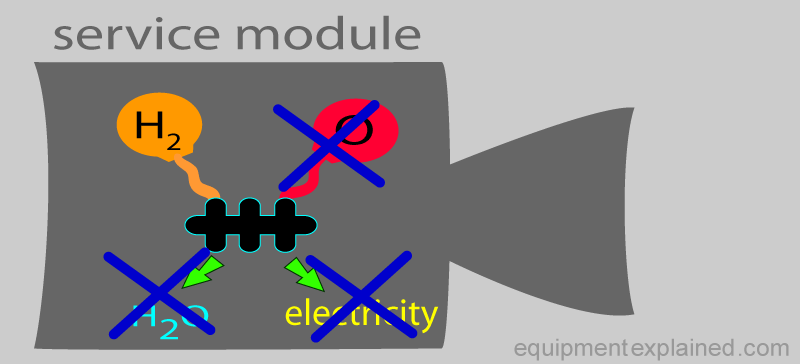
As the oxygen levels were dropping, something drastic had to be done to save the lives of the astronauts.The astronauts were instructed to move over to the lunar module.

Fortunately the lunar module had a good stock of oxygen. The lunar module was designed to, when on the Moon, to let astronauts enter and leave it to explore the lunar surface. Each time its door would be opened for the astronauts to venture out, there would be loss of oxygen. To cope with this regular loss, the lunar module carried a good supply of spare oxygen. So for the moment, while in the lunar module, the astronauts had enough oxygen to breath. However, unfortunately for technical reasons, this oxygen could not be connected to the service module to generate water and electricity
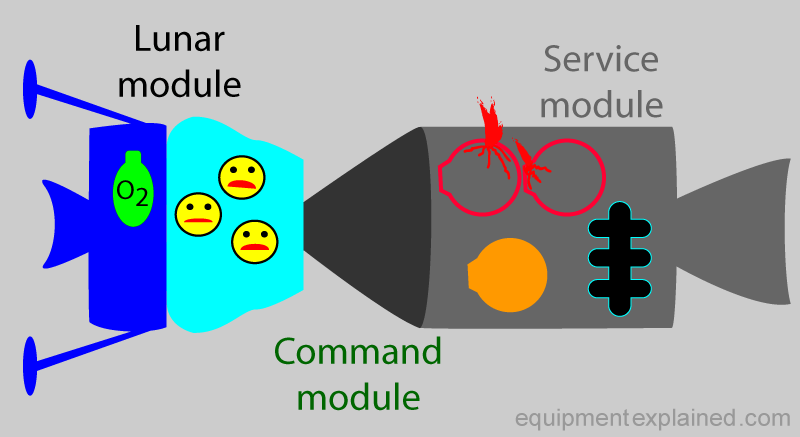
Now to the problem of electricity. The lunar module and the command module had batteries. The battery in the lunar module (” A ” in image below) was designed to provide power only during the short time the astronauts were expected to stay on the Moon. The battery in the command module (” B “) was there to be used only at the last moment, when returning to Earth and was not designed to provide much power at other times.

So the spaceship had very limited battery power available. If the batteries ran out of power, there would be no way to recharge them in space since the service module was damaged. And without electrical power, the vital electronics of the space ship would have failed and the astronauts would not have been able to return to Earth.
The engineers on the ground worked frantically to find a solution. They finally worked out a method to minimise the power consumption of the spacecraft to help prolong the battery life. The ground engineers told the astronauts what electrical systems were “less essential” and these were shut down. By doing this, they managed to reduce the power consumption by 80 %. This was not an easy task. For an example, without electrical power, the temperature in some areas of the spacecraft dropped to nearly 4 degrees centigrade (about 40 Fahrenheit).
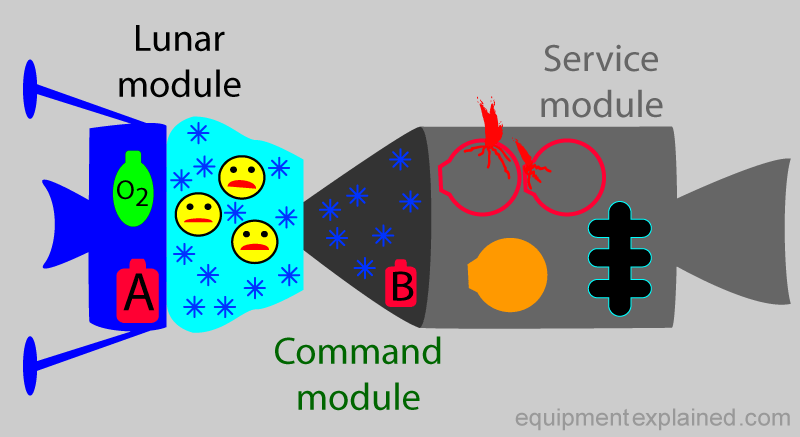
The other big problem was water, since without oxygen, the fuel cell could not create water. The problem was that water was needed not only for the astronauts, but it was also used to cool vital electronic systems. The astronauts restricted their water intake dramatically (e.g. up to 170 ml per person per day) to conserve water. One of the astronauts developed a serious urinary tract infection and it is possible that this was triggered by the dehydration they had to endure.
Due to technical reasons (e.g. to make use of the gravity of Moon), the return path to Earth would have to take them around the Moon first. This meant that the astronauts had to survive for about 4 days before hoping to land on Earth. The ground control center calculated that there should be enough oxygen to survive the journey. They also worked out that there was just about enough electrical power and water for the return journey.
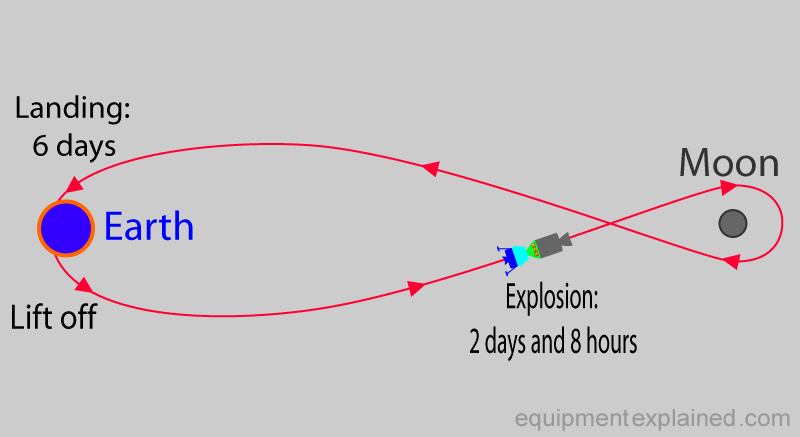
In the midst of all this, the crew were very disappointed that they would not be landing on the Moon. They could only admire the Moon and take pictures from the small windows of their spacecraft.
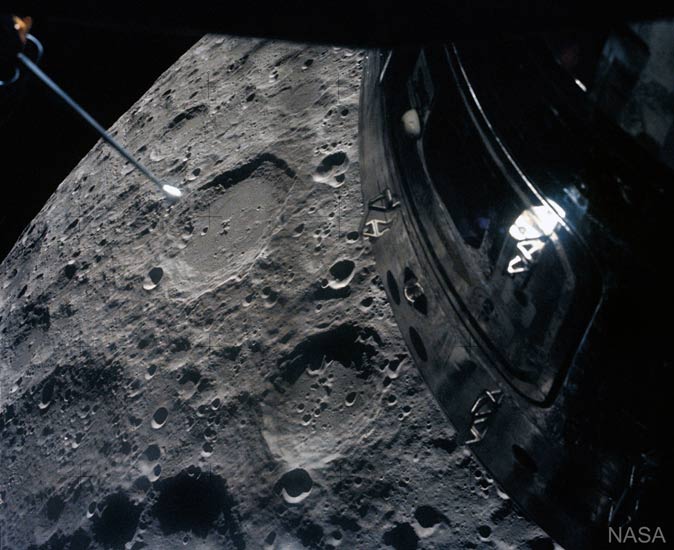
Soon however, there was another problem needing an urgent solution. As all anaesthetists will know, humans put out carbon dioxide in their breath. If this is not removed, the person could die of high carbon dioxide levels. On Earth, where there is plenty of room for gases to spread, high carbon dioxide is not an issue. However, in a confined area such as that found in the lunar module, the carbon dioxide, if not removed promptly, could quickly rise to lethal levels.
Both the lunar module and the command module had “carbon dioxide absorbers” to absorb the carbon dioxide produced by the astronauts. These are shown in pink below.
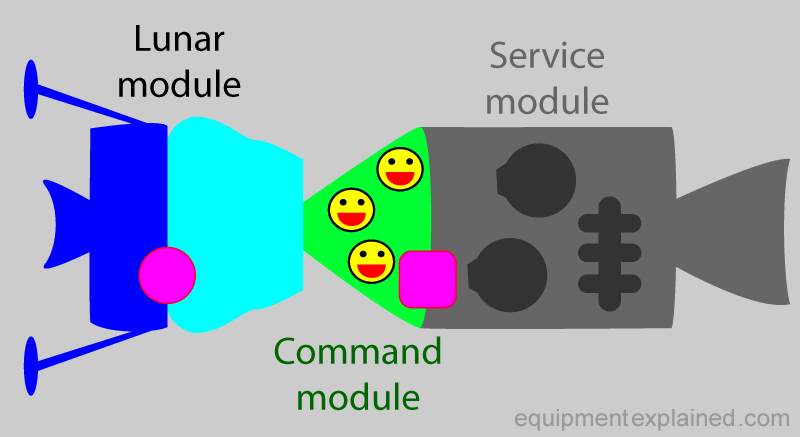
These absorbers had special chemicals to combine with carbon dioxide, thereby removing it from the air in the spacecraft. In the Apollo spacecraft, these absorbers had the chemical Lithium Hydroxide to absorb the carbon dioxide.
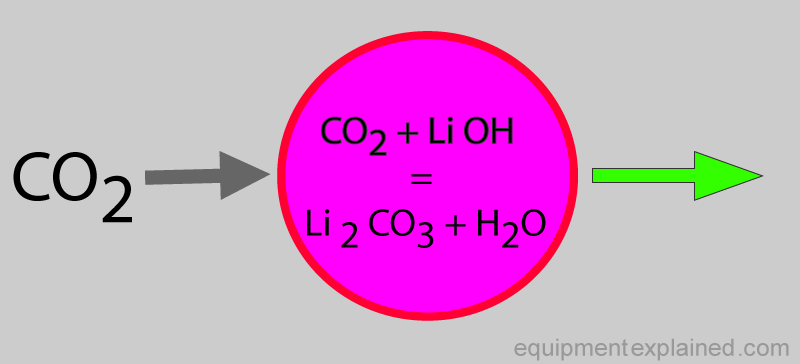
This is somewhat similar to the chemical reactions that happen in carbon dioxide absorbers used in anaesthesia. However, in anesthesia, the main ingredient used is usually Calcium Hydroxide (soda lime) or Barium Hydroxide, rather than the Lithium Hydroxide used in spacecraft.
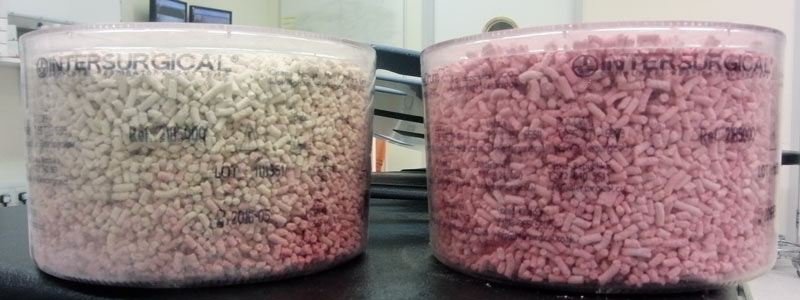
The Lithium Hydroxide chemicals used in the spacecraft to absorb the carbon dioxide were kept in special sealed “containers”. In the lunar module the containers were “circular shaped” whereas in the service module, the containers were “square shaped”. This difference in shape would become an huge problem in our story.
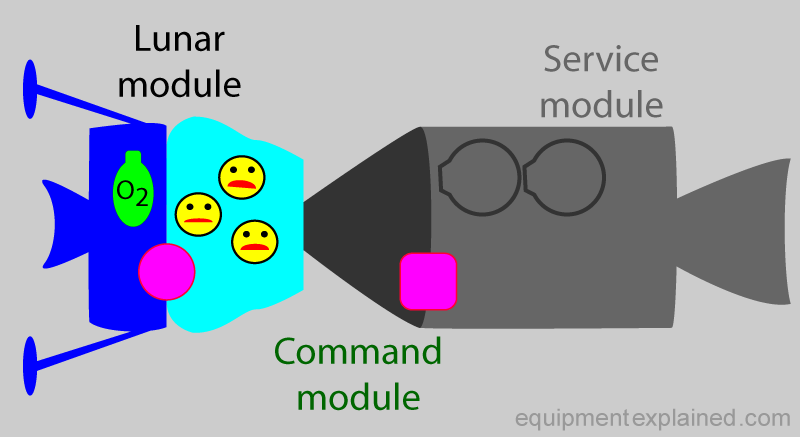
Let us first see the Lithium Hydroxide absorber containers found in the command module.
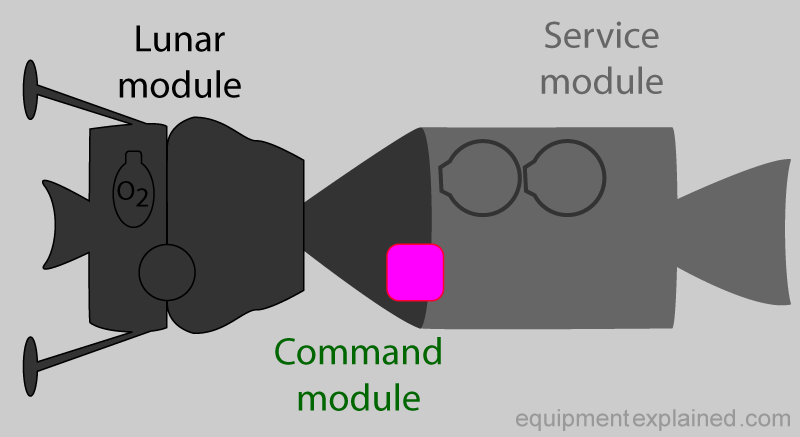
The image below shows one from a command module, which, as you can see, is square shaped.
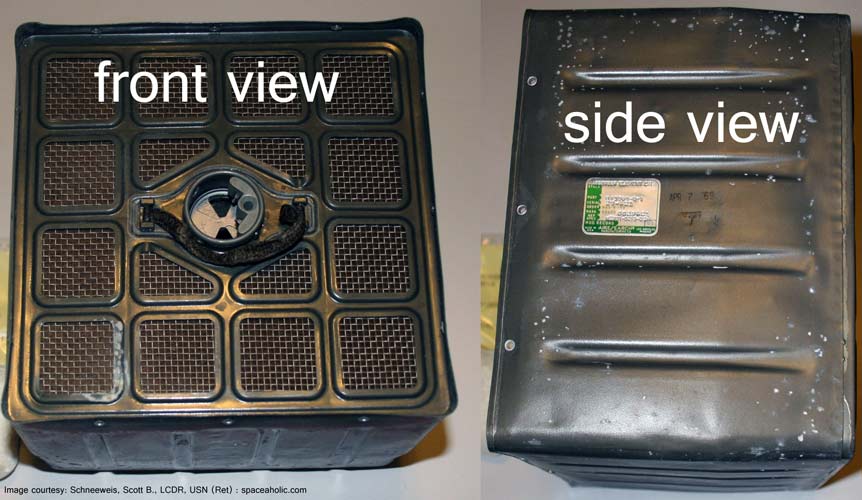
Let me show you, using actual images, how the astronauts would replace such an absorber container in the command module.
After a while the Lithium Hydroxide in a container would “run out” (i.e. the chemical reaction would get “used” up) and the astronauts would remove the now useless container. Image 1 below shows an empty slot from where an used container has been removed. Image 2 shows a new container that has been put into the slot. Image 3 shows the door, which then is closed as shown in image 4.
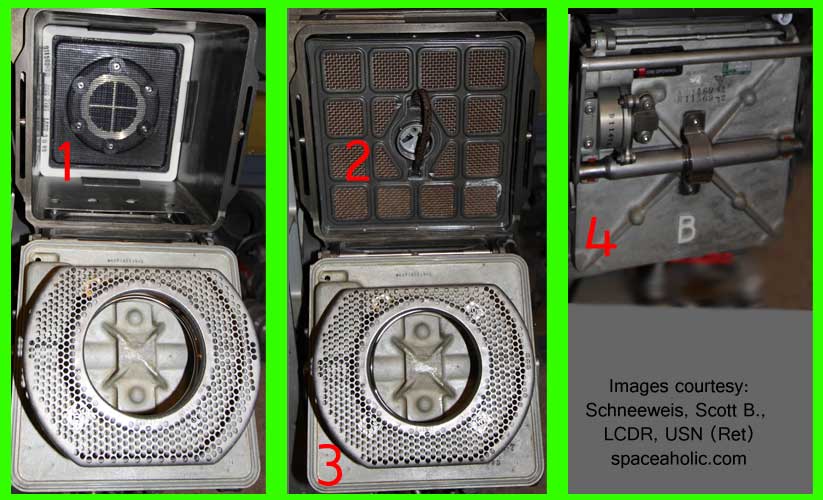
Now let us look at the absorber containers in the lunar module. Here the Lithium Hydroxide was kept in “circular” shaped containers .
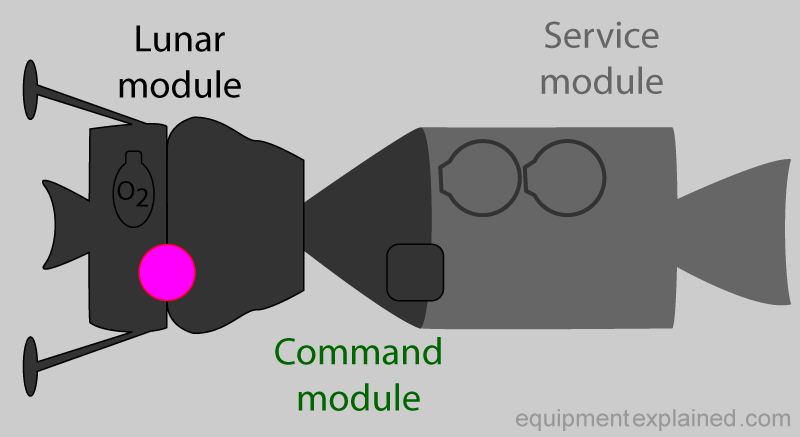
Shown below is the area in the lunar module dealing with carbon dioxide absorption. The circular Lithium Hydroxide containers would be put into the circular chambers behind the lids shown below (red arrow).
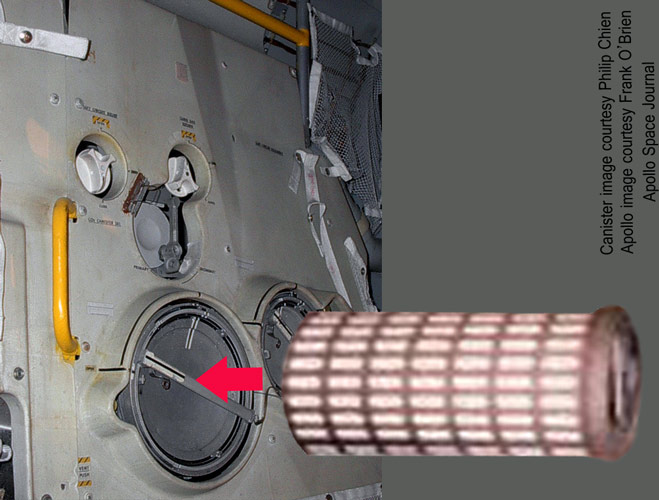
So in summary, the lunar module had its own circular shaped absorber containers and the command module had its own square shaped absorber containers.
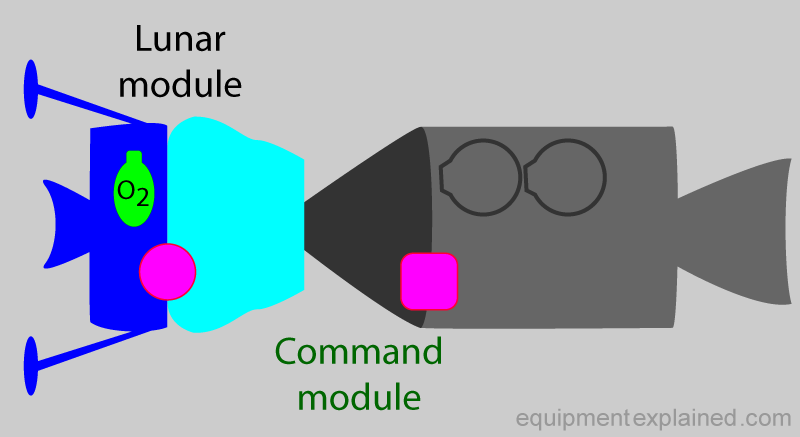
A while ago I said that Apollo 13 had a problem with carbon dioxide. The problem was that the lunar module did not have adequate absorber containers to cope with the three astronauts now seeking refuge in it. The lunar module had only enough absorber containers to cope with 2 astronauts for about 2 days. Now there were 3 astronauts who needed to survive in it for 4 days. If something was not done, there was a very real risk of the astronauts dying of carbon dioxide toxicity.
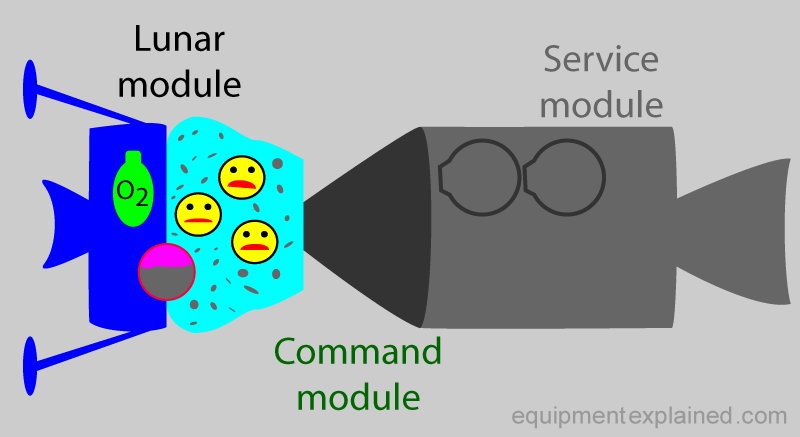
Shown below is an photograph of the interior of a lunar module.The tip of the blue arrow points to the meter that displays the concentration of carbon dioxide in the lunar module air.
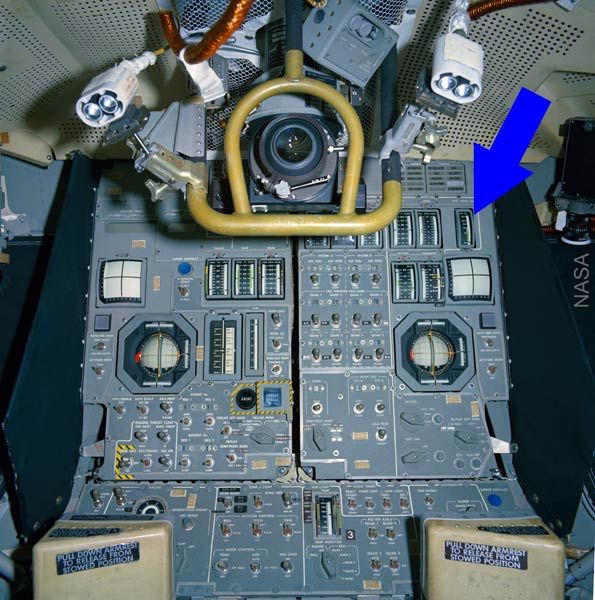
Normally this gauge should show a carbon dioxide level of nearly zero (mmHg). However, with the problem of the inadequate absorber containers in the lunar module, the meter was showing numbers as high as 15 mmHg.
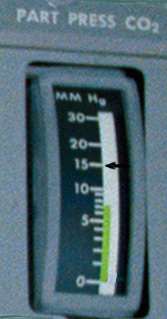
Something had to be done urgently. If the carbon dioxide levels kept rising, it would have killed the astronauts. The tragedy was that there were plenty of carbon dioxide absorber containers in the command module to last the whole journey, but these could not be used in the lunar module because they were of the wrong shape.
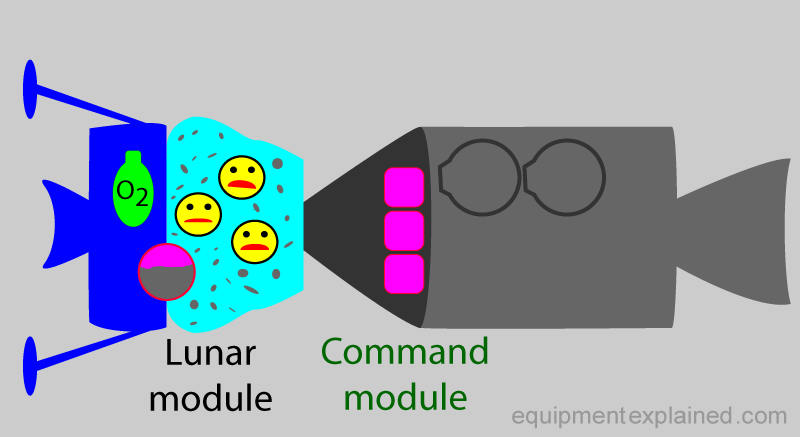
As shown below, the square containers from the command module would not fit in the cylindrical chambers found in the lunar module.
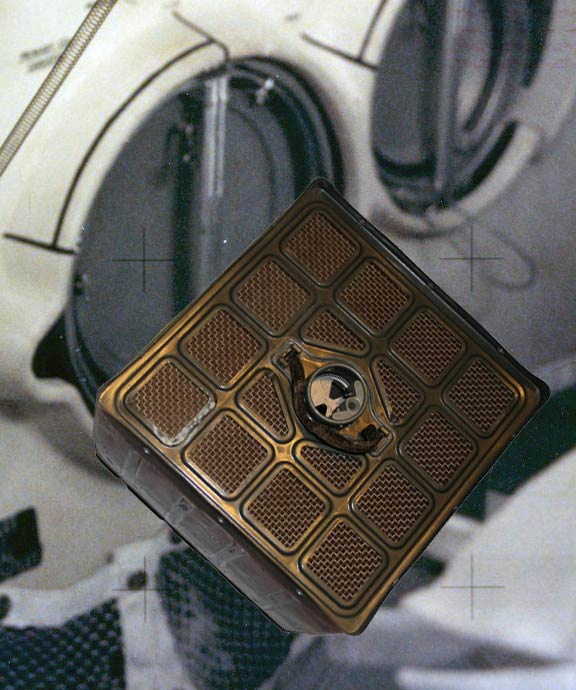
The engineers on the ground worked hard to find a solution. They wondered if they could modify the lunar module’s carbon dioxide absorption system.
When functioning normally, the system consisted of an air pump that sucked carbon dioxide laden air into the circular shaped carbon dioxide absorber container. It then returned carbon dioxide free air back to the astronauts as shown below.
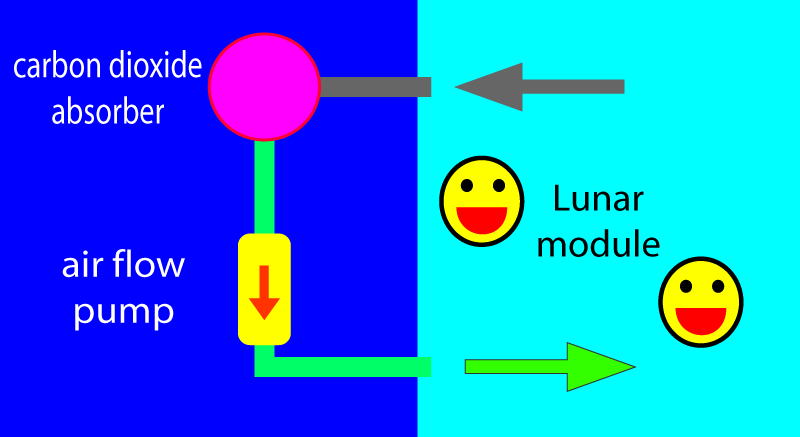
The problem was, once the lunar module carbon dioxide absorber containers got used up, the pump would re circulate carbon dioxide containing air. Eventually, if nothing was done to remedy the situation, the carbon dioxide levels would rise to a fatal level.
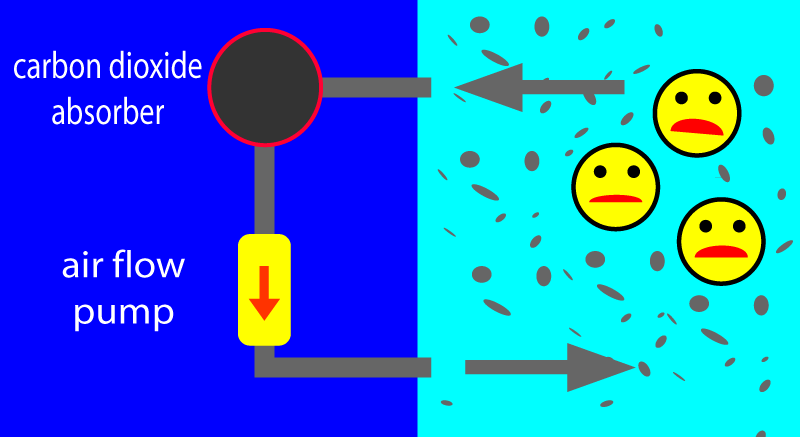
The engineers were trying to find a way to use the square shaped command module containers in the lunar module.
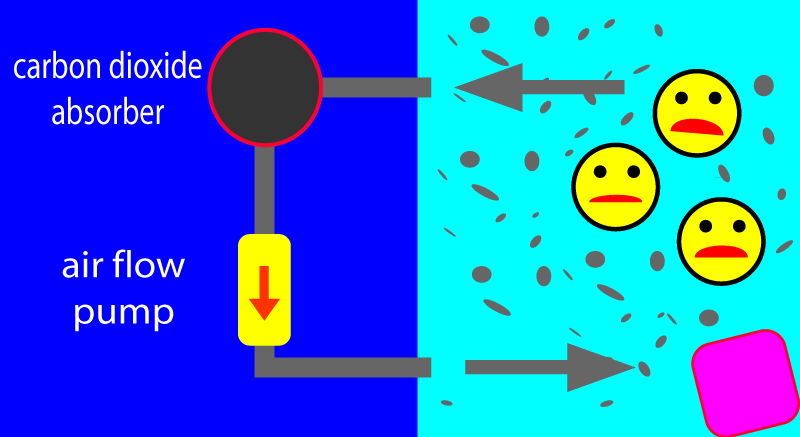
Finding a solution was not as easy as one might have imagined. Whatever solution would have had to use only material found in the spacecraft. There was no option to walk to a nearby shop to buy something !

So this what they advised the astronauts in space to make. First they asked the astronauts to take a square absorber container from the command module.
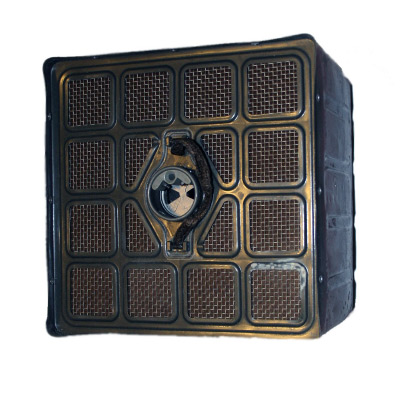
The spacecraft had spare hose pipes. They asked the astronauts to attach one end of a hose to the front of the square absorber container.
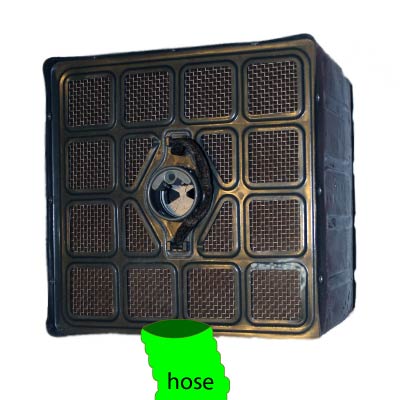
Next a piece of cardboard was taken from one of the spare folders in the spacecraft. It was made into a “arch” and placed over the container. I will tell you later why this card board piece was essential.
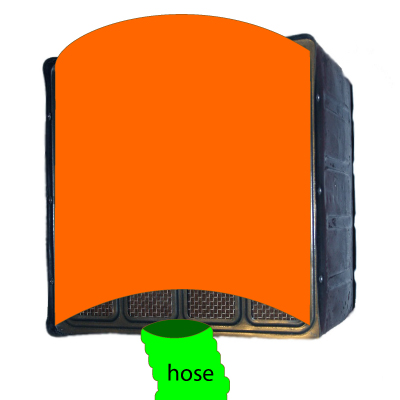
Finally, a plastic bag was draped over the card board and over half the container. Everything was taped to make a good seal.
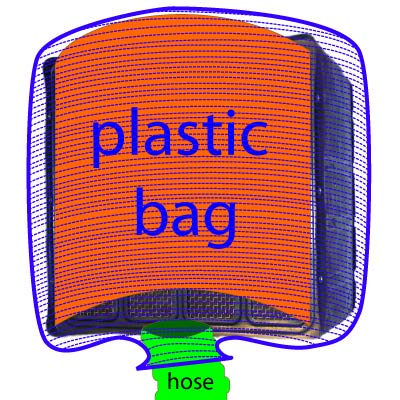
Below is an photograph of a replica of the absorber modification:
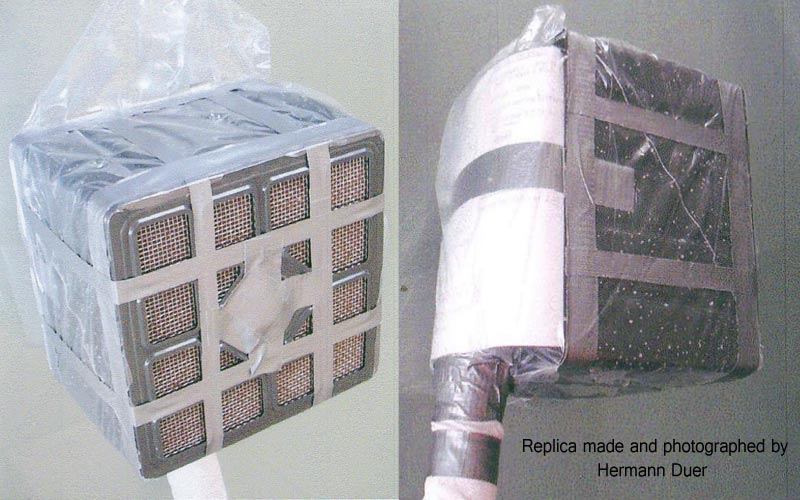
Below is an photograph of the ground control room. The engineers had assembled a sample of what they wanted the astronauts to construct in space. The ground control had no way of sending images to the spacecraft. So using only voice messages, they were able to accurately instruct the astronauts to assemble the contraption described above.

The astronauts then connected the hose of the modified command module absorber container to the “used up” absorber system of the lunar module as shown below. The airflow pump now sucked air with carbon dioxide through the modified absorber. After going through the modified absorber, the carbon dioxide free air was returned to the spacecraft interior. In this way, it was possible to use the square absorbers in the lunar module !
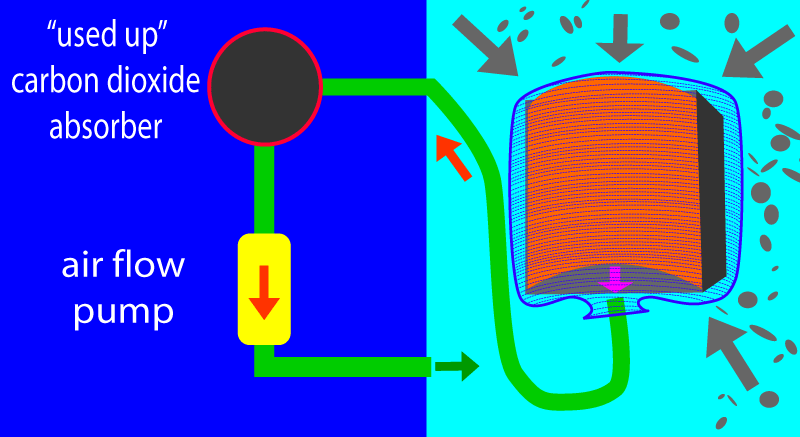
The purpose of the piece of cardboard (shown in brown, below) was to prevent the plastic bag (blue) from collapsing due to the suction force of the air flow pump. If the bag collapsed, it would have blocked the hose shown in green.
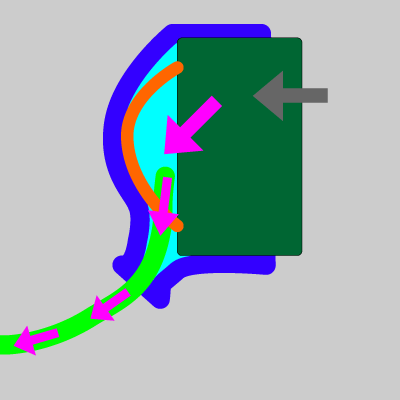
Here is an photograph taken showing the actual modified absorber in use. You can clearly see the square absorber taken from the command module and the hose attached to it. Unfortunately the card board is hidden from view because it is behind the absorber. I am sure you will forgive the astronauts for not taking too many pictures as, at this point, they were not sure if they would even make it back to Earth !
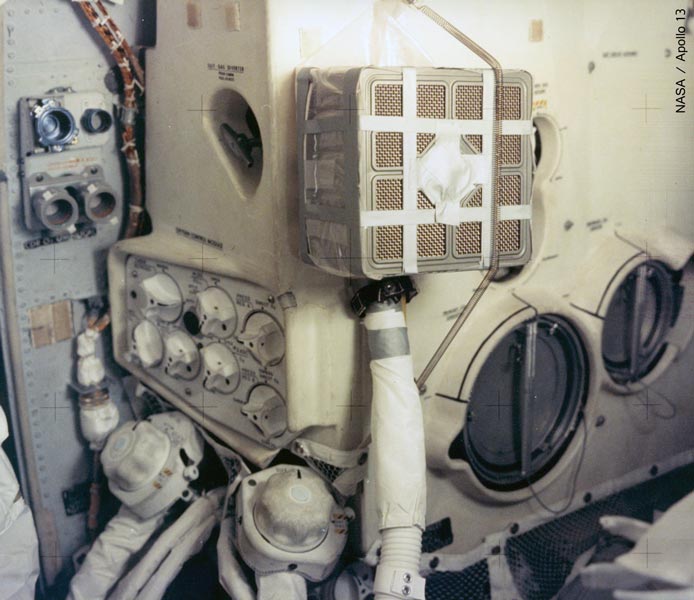
Now the big question was, “Did the system work ?”.
The answer was a resounding “yes”. Within a short time, the carbon dioxide reading had gone down from 15 mmHg to about 0.1 mmHg ! It was a big success !
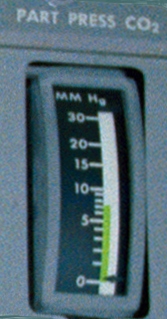
Thanks to the absorber issue being sorted, the astronauts could now deal with the other tricky problems that needed to be sorted if they were to return home. The photograph below shows the astronauts working on some other issues. In the back ground you can see the modified carbon dioxide absorber doing its job.
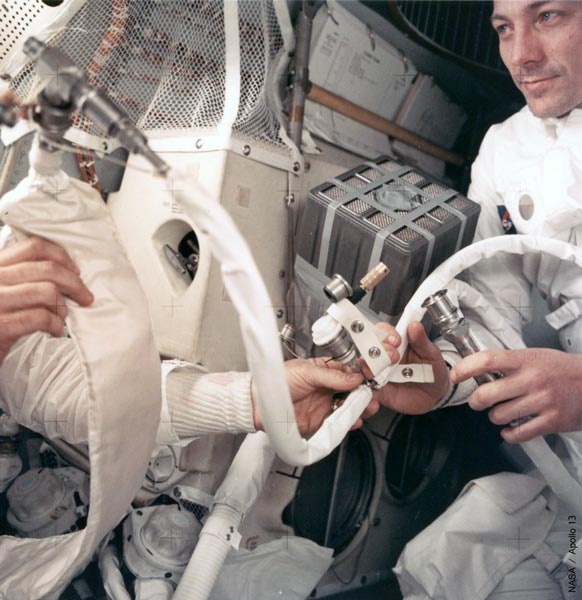
The astronauts were finally nearing Earth. Below is a picture of the Earth taken from the spacecraft.

It had been a long wait for the astronauts. So far, they had been about 6 days in space.
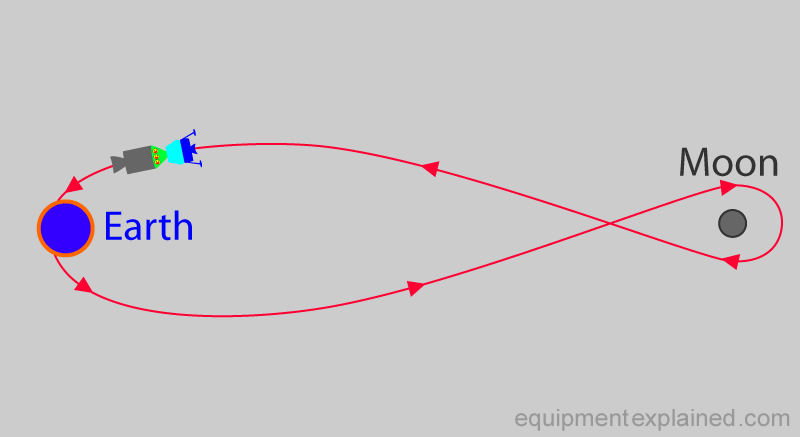
It was time to make final preparations to go home. The initial thing to do was to get rid of the parts of the spacecraft that were not needed anymore. The first part they got rid off was the service module.
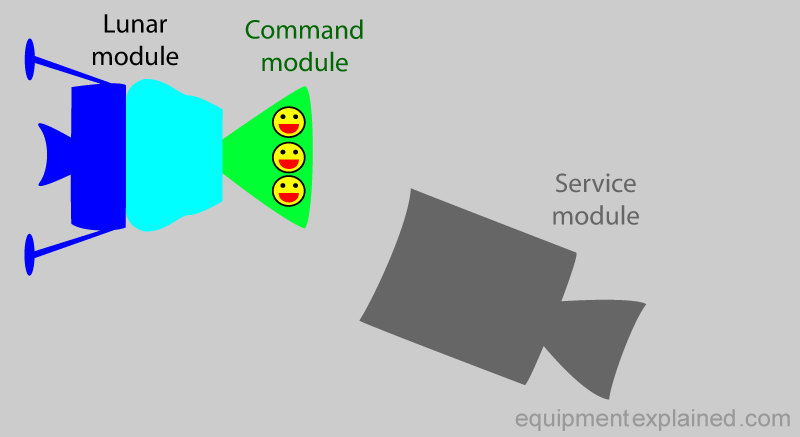
Though the astronauts knew that there was an explosion in the service module, they had not “seen” the damage with their own eyes as they could not go outside and look ! But now, as the service module drifted away, they were finally able to see the damage through their windows. As it moved away, they quickly took the photograph shown below. They were shocked to see the large area of damage (red marked area below). The service module fell towards Earth and due to the extreme speed of the fall and the resulting heat caused by air friction, it would have burnt up in the atmosphere.
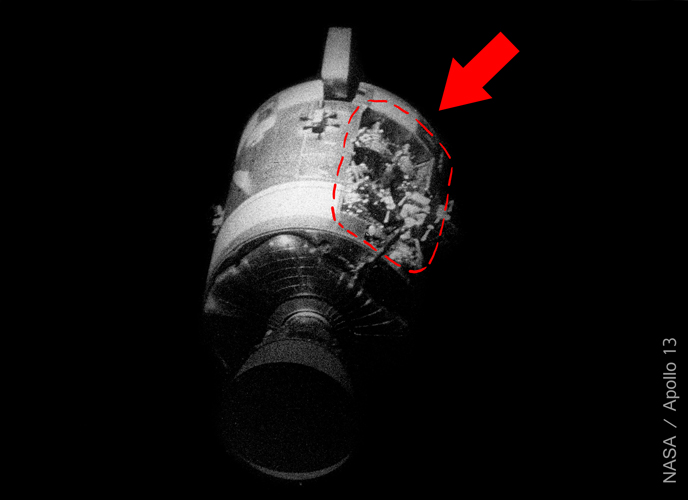
It was now time to wish the lunar module good bye. It had been the “life boat” that had kept the astronauts alive. The astronauts looked at it as it drifted away to fall into Earth.
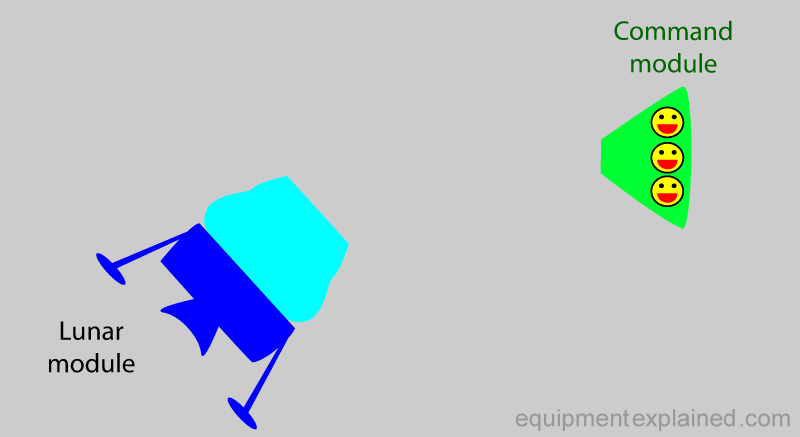
As it fell away, the astronauts took this black and white picture of the lunar module. It too was mostly destroyed by the heat caused by entering the Earths atmosphere at very high speed.
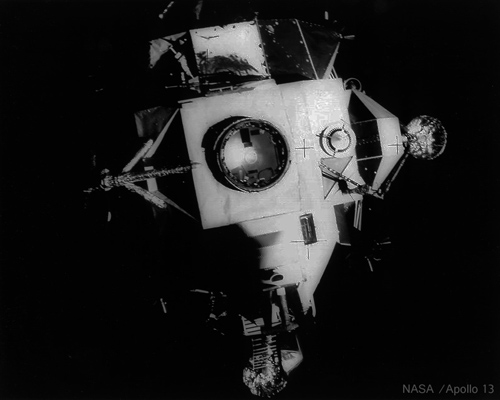
Now , finally it was time for the command module and its three happy astronauts to return to Earth. I mentioned how the service module and the lunar module would have burnt up in the atmosphere due to the high speed of descent through the Earths atmosphere. Fortunately the command module had a special method to survive the fall into the Earth without burning up. On its underside was a special heat shield. This was designed to slowly melt away, and as it did so, it “threw” the excess heat away, protecting the astronauts inside.

Here is an actual picture of an heat shield that has partly burnt away.
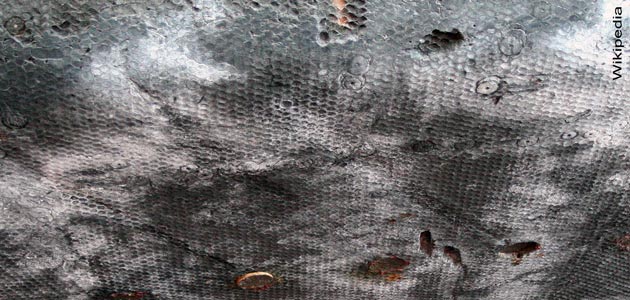
The command module with our astronauts attained speeds as high as nearly 40,000 kilometers / hour ! Fortunately as the sea was nearing, a system of parachutes slowed the capsule down dramatically.

Finally they touched Mother Earth (or would you say, “Mother Sea” ?) .
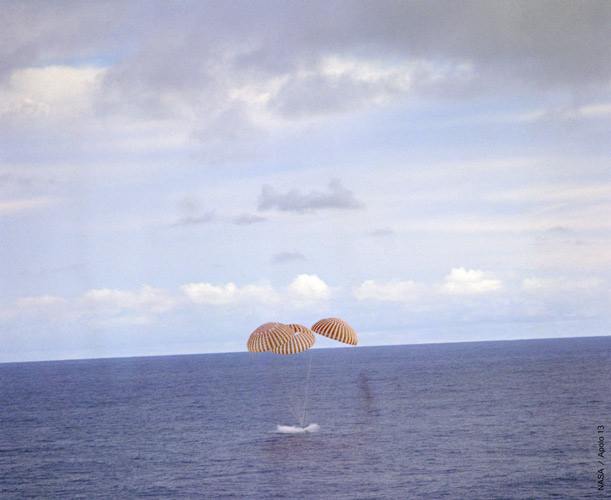
The astronauts were then picked up by special retrieval teams. After being in the cramped confines of the spacecraft, the wide ocean must have been a big relief.
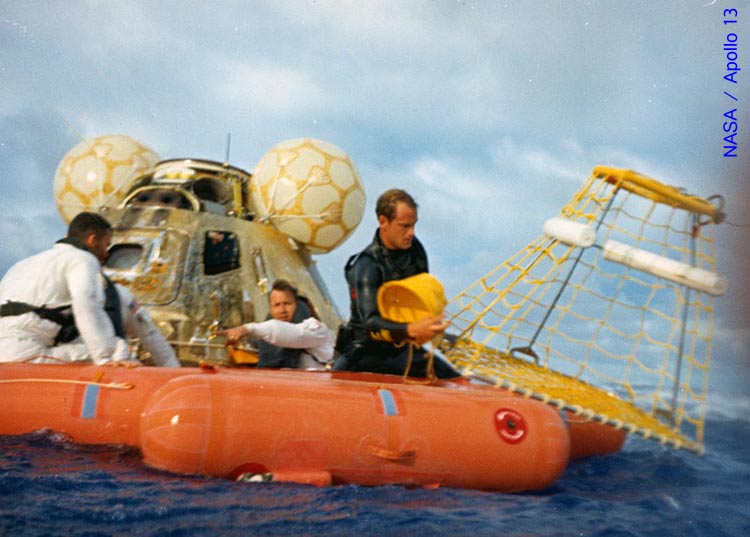
And finally the command module was “rescued”.
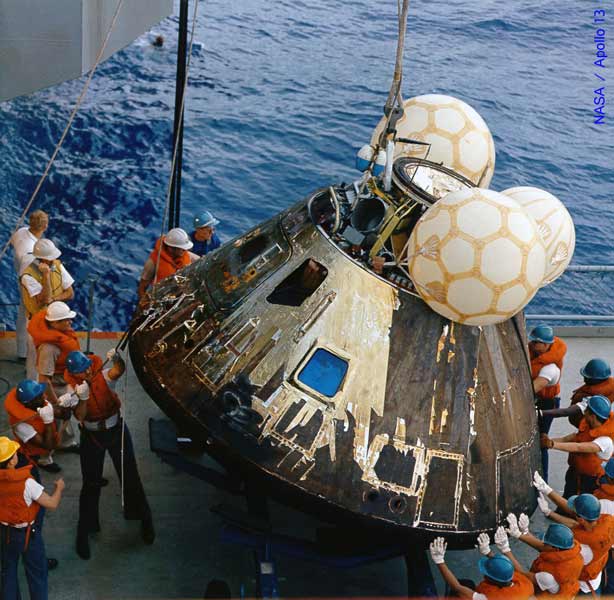
They were now safely onboard the retrieval ship. The photograph below shows them probably sharing their joy with their families. If not for the carbon dioxide absorbers being modified, they wouldn’t have been alive to make these phone calls.

I hope you have enjoyed this story that I have shared with you. Thank you for reading it and please tell your friends about it. See you soon in another section of this website. Bye !
